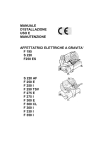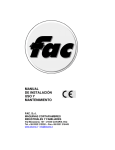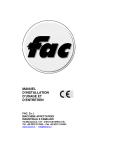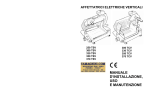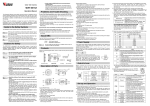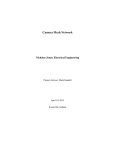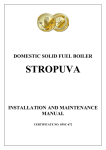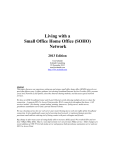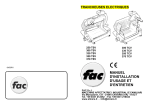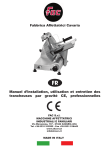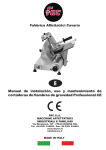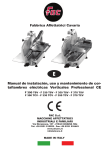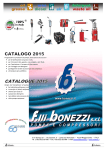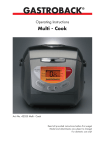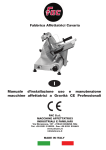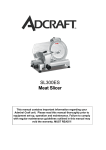Download Service Manual - Whaley Food Service
Transcript
GRAVITY SLICERS F 195 S 220 F250 ES S 220 AF F 250 E F 250 I F 250 TSV F 275 E F 275 I F 300 E F 300 CL F 300 I F 330 I F 350 I NOTES FOR THE USER This manual consists of 28 pages as follows: Title page with notes for the user (back side not printed); Contents, page 1; Page 2 to page 25 carrying progressive numeration (back of page 25 not printed). CONTENTS FOREWORD................................................................................................................... 2 SCOPE OF THIS MANUAL........................................................................................ 2 GENERAL INFORMATION............................................................................................ 2 LIMITS OF USE – SAFETY NORMS ......................................................................... 2 GENERAL SAFETY REGULATIONS ........................................................................ 2 MANUFACTURER'S WARRANTY AND LIABILITY .................................................. 3 PLATES – CONFORMITY MARKS............................................................................ 3 ENVIRONMENTAL CONDITIONS OF USE .............................................................. 3 PACKING ....................................................................................................................... 4 OPENING THE BOX .................................................................................................. 4 TECHNICAL DESCRIPTION AND PROPOSED CONDITIONS OF USE..................... 5 GENERAL DESCRIPTION......................................................................................... 5 MECHANICAL AND ELECTRICAL SAFETY DEVICES ............................................ 5 WARNING: RESIDUAL RISKS .................................................................................. 5 DIMENSIONS............................................................................................................. 6 MAIN TECHNICAL DATA .......................................................................................... 7 SUPPLIED LITERATURE AND ACCESSORIES ...................................................... 8 PRODUCTS THAT CAN BE SLICED ........................................................................ 8 PRODUCTS THAT MUST NOT BE SLICED: ............................................................ 8 MAIN COMPONENTS I.............................................................................................. 9 MACHINE COMMISSIONING AND FUNCTION TESTS............................................. 11 INSTALLING THE MACHINE................................................................................... 11 ELECTRICAL CONNECTION .................................................................................. 11 COMMANDS ............................................................................................................ 12 USING THE MACHINE ................................................................................................ 13 LOADING THE PRODUCT ON THE TRAY AND SLICING..................................... 13 CLEANING THE SLICER............................................................................................. 14 GENERAL ................................................................................................................ 14 DISASSEMBLING THE MACHINE FOR CLEANING .............................................. 14 REASSEMBLING THE MACHINE ........................................................................... 15 MAINTENANCE ........................................................................................................... 15 GENERAL ................................................................................................................ 15 BLADE SHARPENING ............................................................................................. 15 SHARPENING.......................................................................................................... 16 LUBRICATION ......................................................................................................... 18 ADJUSTING THE MOTOR BELT TENSION ........................................................... 19 TROUBLESHOOTING AND REMEDIES .................................................................... 20 DISMANTLING THE SLICER ...................................................................................... 21 ELECTRICAL DIAGRAM SIG. 97 (versions 195-220-250 E) .................................. 22 ELECTRICAL DIAGRAM 97 FA (for versions 250 I-300 E–275 I)........................... 23 ELECTRICAL DIAGRAM 97 FA (for versions 300 I – 350 I) ................................... 24 THREE-PHASE ELECTRICAL DIAGRAM 1893 (all versions) ................................ 25 1 FOREWORD SCOPE OF THIS MANUAL This manual contains all the necessary information to install, use and service the gravity slicers for food (please see models in paragraph "Technical Description"). The scope of this document, hereinafter the "manual", is to permit users, and especially end users, to take all the cautions and provisions possible for using this machine safely and for a long time. GENERAL INFORMATION LIMITS OF USE – SAFETY NORMS These machine were designed and built to slice foodstuff in compliance to the norms of the 89/392 - 89/336 Directive and following amendments CE 91/368 93/44 - 93/68 CE, EN 1974 directive 89/109. GENERAL SAFETY REGULATIONS The slicers must be used only by suitably trained personnel. Furthermore, this personnel must have read this manual carefully. In particular, please comply to the following instructions Install the machine according to the instructions contained in the "Installation" section. Do not remove the transparent protections, do not modify nor exclude the mechanical and electrical safety devices. Do no use the machine with improvised connections, or provisional or non insulated cables. Check the power cable and gland plate on the machine body regularly and when necessary have them replaced by qualified personnel. In case of anomalies, defective operation, incorrect movement, unusual noise, etc stop the machine immediately. Before cleaning or servicing, disconnect the machine from the mains. Always use scratch-proof and non-slip gloves during cleaning or maintenance. Lay or remove the goods to be sliced on the sliding plate only when the latter is completely pushed back and the thickness control knob positioned to 0. To move the carriage tray when slicing, use the handle or the product grip handle. For extraordinary maintenance (to replace the sharpener wheels, the blade, or others) please contact the manufacturer or qualified and duly authorized personnel. Avoid running the slicers with no product on it The slicers are equipped with a ventilated motor, except for the F 195 model for which operating time must not exceed 15 minutes to avoid motor overheating. After a period of rest, operation can be resumed. WARRANTY: 1 YEAR except for the electrical parts 2 MANUFACTURER'S WARRANTY AND LIABILITY The manufacturer's warranty covering the good functioning of the machines and their compliance to the service for which they have been designed depends on the correct application of the instructions contained in this manual. The Manufacturer assumes no liability either direct or indirect deriving from: Failure to comply with the instructions contained in this manual; Use of the machine by personnel who has not read or fully understood the content of this manual; Use not complying to the specific norms currently applicable in the country of installation; Unauthorized modifications and/or repairs; Use of non original accessories or spare parts. Exceptional events. PLATES – CONFORMITY MARKS The machines have been constructed in compliance with the European Directive 89/392 and subsequent amendments. All the parts making the machine meet the terms of the Directive and the CE marks have been applied to substantiate this compliance. The plate carrying the Manufacturer's data, the machine data and the CE mark are applied onto the machine base under the blade guard tie-rod knob. This plate must never be removed and must always be legible. In case of wear or damage, the user must replace it. ENVIRONMENTAL CONDITIONS OF USE - Temperature............................................................. from -5 °C to + 40 °C - Relative humidity ........................................................................ max 95% 3 PACKING OPENING THE BOX On reception check packaging integrity, otherwise inform the forwarding agent or the area agent immediately. To unpack the machine, proceed as follows: Open the box and remove your copy of the manual of use and maintenance, then proceed according to the instructions found on that manual; Lift the machine still wrapped in a transparent polyethylene sheet and extract it from the box; Now check the box content and make sure it corresponds to what shown on the external label. WARNING: The packaging components (cardboard, polyethylene, and others) are classified as normal solid urban waste and can therefore be disposed of without difficulty. In any case, for suitable recycling, we suggest disposing of the products separately (differentiated waste)according to the current norms. DO NOT DISCARD ANY PACKAGING MATERIALS IN THE ENVIRONMENT! 4 TECHNICAL DESCRIPTION AND PROPOSED CONDITIONS OF USE GENERAL DESCRIPTION The machine is essentially made of a base supporting a circular blade mounted in tilted position. This blade is driven by an electrical motor to slice foodstuffs. The machine is equipped with a carriage holding a product tray and sliding on tracks mounted under the base top, parallel to the blade. Slice thickness is adjusted by means of a gauge plate mounted in front of the blade. This plate, against which rests the product to be sliced is moved transversally with respect to the blade by a value corresponding to the desired slice thickness. The product is fed to the machine (towards the gauge plate) by gravity. All the machine components are made of polished and anodically oxidized aluminium alloy, of stainless steel and food grade plastic material. The blade is driven by an electrical motor, transmission is by means of a longitudinally grooved belt. The machine is started and stopped by a control button provided with auxiliary circuit preventing accidental restarts after an outage. Some of the machine models have a user-friendly and safe built-in blade sharpener. MECHANICAL AND ELECTRICAL SAFETY DEVICES The following mechanical safety devices were installed: A series of aluminium and transparent plastic guards on the product carriage. The following electrical safety devices were installed: Start/stop button system requiring a voluntary restart of the machine in the case of an outage or interruption of the power supply. Safety micro-switch preventing the motor from starting when the blade guard is removed (not available on the F 195, S 220 and F 250ES machines). WARNING: RESIDUAL RISKS Notwithstanding all the possible cautions taken during the design and the construction of the machine, residual risks (cutting) still exist during use or during cleaning or maintenance. Therefore be careful and PAY THE UTMOST ATTENTION to what you are doing. DO NOT use the machine if you are not in perfect psychological and physical conditions. DO NOT ALLOW anyone near the machine when it is in use. ALWAYS wear gloves that can resist cuts or tears when cleaning, lubricating or sharpening the blade. Slice only the products mentioned as sliceable. NEVER try to slice products that have been mentioned as non sliceable. 5 DIMENSIONS F 195 S 220 F250 ES S 220 AF F 250 E F 250 I F 250 TSV F 275 E F 275 I F 300 E F 300 CL F 300 I F 330 I F 350 I 6 MAIN TECHNICAL DATA GRAVITY SLICERS 0,20 S220 220AF 0,25 F250E F250I F250ES 0,30 0,35 195 220 250 300 300 300 0/15 0/15 0/16 Version F195 Motor HP Blade Ø mm Rpm Min. slice thickness mm cut: L x H mm A mm B mm C mm D mm E mm Peso: Kg F275E F275I F300E F300I F300CL F330I F350I 0,30 0,35 0,35 0,50 0,35 0,50 0,50 250 275 275 300 300 300 330 350 300 300 300 300 280 300 280 260 0/16 0/16 0/16 0/16 0/16 0/16 0/16 0/16 160x140 210x160 240x190260x190240x190260x190260x220285x230310x220285x250325x260 255 345 360 520 315 10 280 290 415 440 405 425 580 620 340 370 13,5 15,5 Separate Sharpenerseparate Built-in Built-in 340 465 480 630 440 21 290 440 440 620 390 16,5 340 465 495 640 440 22 340 465 495 650 440 23 410 530 540 770 465 30 350 570 560 870 500 27,5 410 530 550 770 465 32 415 580 585 890 480 36 Built-in Built-in Built-in Built-in Built-in Built-in Built-in Built-in VERTICAL SLICERS Version Motor HP Blade Ø mm Rpm Slice thickness mm Cut: L x H mm A mm B mm C mm D mm E mm Weight: Kg Sharpener F250TSV F250TCV 0,35 250 300 0/16 F300TSV F300TCV 0,50 300 280 0/16 F330TSV E F330TCV E 0,50 330 260 0/16 F350TSV F350TCV 0,50 350 260 0/16 F370TSV F370TCV 0,50 370 260 0/16 260x190 260x200 250x210 300x265 290x275 360 460 520 530 500 24 Built-in 420 530 550 710 610 40 Built-in. 420 530 550 710 610 41 Built-in. 530 650 650 820 640 45 Built-in. 530 650 650 820 640 46 Built-in. Intermittent service (5 min. pause every 15-20 min. of work) only for F 195. All the other machines have a ventilated motor. Supply voltage: Please see data plate on the machine base 7 SUPPLIED LITERATURE AND ACCESSORIES If not otherwise defined at the moment of order, the machines are supplied together with the following: EU conformity declaration Instructions manual for installation, use and maintenance. PRODUCTS THAT CAN BE SLICED All types of cold cuts (raw, cooked, smoked); Meat without bone (raw or cooked, at a temperature not less than + 3 °C; Cheese cuts (obviously types that can be sliced such as gruyere, fontina, etc.). PRODUCTS THAT MUST NOT BE SLICED: 1. 2. 3. 4. Frozen or deep-frozen food; Food containing bones (meat or fish); Vegetables (all types); Any other non-food product. 8 MAIN COMPONENTS I F 195 S 220 F250 ES 1. 2. 3. 4. 5. 6. 7. 8. 9. 10. STARTUP BUTTON (GREEN) STOP BUTTON (RED) N.A. SLICE THICKNESS CONTROL KNOB ADJUSTABLE FOOT CARRIAGE TRAY SUPPORT BASE PRODUCT TRAY BLADE PLATE PRODUCT GRIP 11. BLADE 12. PRODUCT GRIP HANDLE 13. MANUFACTURER IDENTIFICATION PLATE, MACHINE DATA AND UE MARKS 14. PRODUCT GRIP HAND PROTECTION 15. PRODUCT TRAY HAND PROTECTION 16. PRODUCT TRAY HANDLE 17. BLADE PLATE TIE-ROD 18. SUPPLY CORD 19. GAUGE PLATE 20. SHARPENER 9 MAIN COMPONENTS S 220 AF F 250 E F 250 I F 250 TSV F 275 E F 275 I F 300 E F 300 CL F300 I F 330 I F 350 I 1. 2. 3. 4. 5. STARTUP BUTTON (WHITE OR GREEN) STOP BUTTON (RED OR BLACK) N.A. SLICE THICKNESS CONTROL KNOB ADJUSTABLE FOOT 6. CARRIAGE TRAY SUPPORT 7. BASE 8. PRODUCT TRAY 9. BLADE PLATE 10. PRODUCT GRIP 11. BLADE 12. PRODUCT GRIP HANDLE 13. MANUFACTURER IDENTIFICATION PLATE, MACHINE DATA AND EU MARKS 14. PRODUCT GRIP HAND PROTECTION 15. PRODUCT TRAY HAND PROTECTION 16. PRODUCT TRAY HANDLE 17. BLADE PLATE TIE-ROD 18. SUPPLY CORD 19. GAUGE PLATE 20. SHARPENER 10 MACHINE COMMISSIONING AND FUNCTION TESTS INSTALLING THE MACHINE Position the machine on a well leveled, smooth and dry top suitably dimensioned to withstand the machine weight. ELECTRICAL CONNECTION Install the machine near a EU compliant outlet derived from a system meeting the current norms. The user is responsible for ascertaining that the electrical system is suitably dimensioned and functions correctly (supply line, outlet, distribution panel, differential protecting breaker, grounding). Before carrying out the connection ascertain that the mains characteristics correspondent to those indicated on the machine plate. 11 COMMANDS START AND STOP BUTTONS Press the white or green button (1) to start running the blade. The light turns on to indicate that the machine works correctly. Press the red or black button to stop the blade. Slice thickness can be adjusted by turning the graduated knob (4) counterclockwise. Thickness adjustment range: see paragraph "Technical description and conditions of use”. FUNCTIONING TEST AND BLADE ROTATION DIRECTION Start the machine and check whether the light is on; make sure that the blade rotates in the direction indicated by the arrow (counterclockwise if you look at the machine from the blade plate side). For machines with three-phase supply: if the blade rotates in the other direction, stop the machine immediately and call qualified personnel to invert the plug supply wires. Ascertain that the carriage and the product grip slide correctly; Ascertain that the gauge plate works and adjust thickness to desired value. 12 USING THE MACHINE LOADING THE PRODUCT ON THE TRAY AND SLICING Ascertain that the thickness control knob is correctly positioned to '0'. Draw back the carriage completely (towards the operator) to loading position. Lift the product grip by pulling it away by 10 cm from the blade and put it in rest position. Lay the product to be sliced against the wall on the operator side. Secure by means of the product grip by exerting a slight pressure. Adjust the thickness gauge. Start the blade by pressing on the green button. Grip the handle affixed onto the plate and start the forward and backward cutting movement. The product travels towards the gauge plate by gravity. When the product weight or its dimensions do not provide a satisfactory cut by effect of the gravity, use the product grip handle. When finished, return the thickness control knob to '0' and draw the carriage back. Stop the blade by pressing the red button. 13 CLEANING THE SLICER GENERAL The machine must always be accurately cleaned at least once a day, and more often if necessary. Always use protective gloves. DISASSEMBLING THE MACHINE FOR CLEANING Disconnect the plug from the mains; Turn the gauge plate know to '0'; Remove the various components as described in the following paragraphs: Unscrew (counterclockwise) the blade guard rod; If the blade guard is blocked, press on the rod knob to move it a little; Extract the rod and remove the blade guard using for this operation only the side knobs. Loosen and remove the two fixing screws with knurled head; Remove the slice guard. To clean the machine body and the blade use only a cloth damped with water and biodegradable lathery detergent having 7-8 pH and at a temperature not below + 30°C. Do not clean the machine by using water or vapor spruìys or similar systems. WARNING: Use scratch-proof and non-slip gloves to carry out the following operations. Proceed carefully and pay attention to what you are doing. Danger of cutting! 14 REASSEMBLING THE MACHINE Proceed as indicated for the previous operations but in reverse order. MAINTENANCE GENERAL The operator is allowed to perform the following maintenance operations: Blade sharpening: regularly (intervals and duration obviously depend on the use of the machine, time of use and type of product sliced); Lubrication of carriage sliding guides: once a week. Lubrication of product grip sliding bar: once a week. Adjustment of motor belt tension: as required. Checking the power supply cord conditions and of the gland plate: from time to time. . WARNING Maintenance must always be carried out when the machine is disconnected from the mains and if no other position is specifically required, with the thickness control knob on '0'. not specifically The following maintenance operations are to be entrusted only to personnel authorized by the manufacturer: Replacing the blade; Replacing the sharpener stones; Replacing the motor transmission belt; Replacing electrical system components under the machine base; Repairing structural parts, repairing the components under the base. BLADE SHARPENING Before proceeding, clean the machine accurately as explained in the previous paragraphs: WARNING Sharpening can be done only up to 12 mm of the blade diameter value. Beyond this value, the BLADE MUST BE REPLACED ONLY by personnel AUTHORIZED BY THE MANUFACTURER. 15 SHARPENING Models with separate sharpener 1. Clean the blade accurately using denaturized alcohol to degrease it. 2. Turn the graduated knob (1) towards the left to open completely. 3. Remove the sharpener from its box, unscrew the knurled knob and insert the threaded metallic pin inside the hole (2) provided for on the product tray so that the two emery wheels are turned towards the blade. Snap into place by pressing on the lower wheel button (3). The lower wheel must remain inserted for a length equal to half of its diameter between the blade on which it rests and the adjustment plate. 4. Insert the plug into the outlet and operate the switch while using the handle to block the product tray then the sharpener in the above position (4); 5. Allow the blade to rotate for about 30 to 40 seconds then use the switch to stop it. Brush a pencil lightly on the external side of the blade to check for a slight spud; restart the blade by maintaining the wheel button (5) pressed for 10 seconds. 16 SHARPENING Versions with built-in sharpener To sharpen the blade periodically as soon as the cutting capacity decreases. Please proceed as per the following instructions: 1. After disconnecting form the mains, clean the blade accurately using denaturized alcohol to degrease it. 2. Loosen the knob (1) and turn the sharpener (2) by 180° and insert the whells on the slicer blade. Relock the knob. 3. Operate the switch (3) and press the button (4); 4. Allow the blade to rotate for about 30 to 40 seconds then use the switch (3) to stop it. Brush a pencil lightly on the external side of the blade to check for a slight spud; We advise performing this operation with the utmost care as the blade is extremely sharp. 5. If some spud is found, operate the switch (3) again for 3 to 4 seconds by pressing the buttons 4 and 5 at the same time. DO NOT PROLONG THIS OPERATION BEYOND THE FEW SECONDS MENTIONED OTHERWISE THE BLADE EDGE WILL WARP. 6. After completing sharpening, we advise cleaning the wheels using a small brush and alcohol. 7. Now return the sharpener to its original position. 17 LUBRICATION Carriage sliding guides product grip (once a week) Use only the oil provided, otherwise use white Vaseline oil. DO NOT USE VEGETAL OILS. Spread a small quantity of oil on the bar and move the assembly 3 or 4 times. Clean as required to remove excess of oil. 18 ADJUSTING THE MOTOR BELT TENSION After a given period of service an unusual noise may occur because of the belt bedding. In this case, tighten the belt-stretcher on the side of the motor under the machine base. 19 TROUBLESHOOTING AND REMEDIES The table below indicates the most common problems that may arise during slicing and the necessary remedies. PROBLEM POSSIBLE CAUSE REMEDY The machine does not start when the green button is pressed No power supply The blade guard is not correctly positioned. Defective electrical control circuit. Ascertain that the plug is is correctly inserted. Check Call technical assistance The machine does not start, and there is continuous noise like a buzz (only in the case of machines equipped with three-phase motors. The motor is running on single-phase mode Press the red button immediately and have the power supply cord and the circuits upstream verified by qualified personnel. When the green button is pressed, the machine stats, but the white functioning light is not on. Defective indicator Do not use the machine when the pilot lamp is not on. Call technical assistance The machine starts, but there are vibrations. The motor is very hot and there is a bad smell. Defective motor or transmission. Do no use the machine. Call technical assistance. Under strain, the machine slows down or comes to a stop. Defective transmission Call technical assistance Excessive resistance to product slicing. The blade is blunt Sharpen the blade The slices are ragged and/or shaped irregularly The blade is blunt The blade is excessively worn out Sharpen the blade Call technical assistance Unsatisfactory blade sharpening Worn wheels Replace the wheels. Call technical assistance The product trayu does not slide Guides are insufficiently lubricated Lubricate When the red button is pressed, the machine does not stop Defective electrical control circuit Stop the machine, unplug from mains and call technical assistance 20 DISMANTLING THE SLICER These machines are made of the following elements: Aluminium frame; Stainless steel fittings and others; Electrical parts and cords; Electrical motor; Plastic materials, etc. Whether dismantling is entrusted to third parties or done in-house (in that last case you will have to separate the various materials) please note that disposal of the materials can only be carried out by duly authorized businesses. In any case, please comply to the current norms of your country. WARNING In any case, to remove the blade and dispose of it, you must contact the manufacturer or personnel duly authorized by the manufacturer. NEVER DISPOSE OF WASTE IN AREAS WHERE ACCESS IS NOT DELIMITED BY BARRIERS AND FORBIDDEN BY WARNING SIGNS AS THIS WASTE REPRESENTS A SERIOUS DANGER, ESPECIALLY FOR CHILDREN AND ANIMALS. ANY RESPONSIBILITY ARISING OUT OF INCORRECT DISPOSAL FALLS ON THE OWNER. 21 ELECTRICAL DIAGRAM SIG. 97 (versions 195-220-250 E) 22 ELECTRICAL DIAGRAM 97 FA (for versions 250 I-300 E–275 I) 23 ELECTRICAL DIAGRAM 97 FA (for versions 300 I – 350 I) 24 THREE-PHASE ELECTRICAL DIAGRAM 1893 (all versions) 25


























